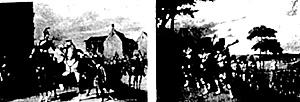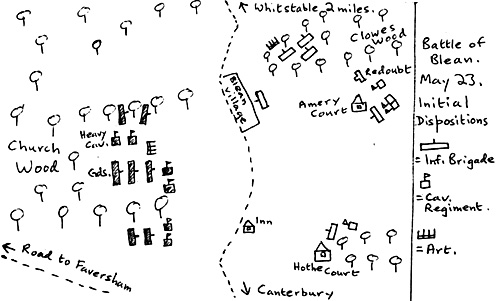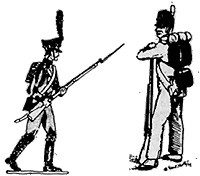A campaign game played by the Mid-Herts Group; for strategic rules see June "Newsletter"; basic representation - one figure = 50 men, one gun = a battery of 6, tactical rules scale 1 inch = 50 yds.)
Battle of Blean, May 23rd, 1810
 On the 22nd the large army collected by the British at Faversham, totalling well over 15,000
men, moved against the Dunkirk Hill position, expecting a stiff fight in the wooded hilly terrain but still supremely confident after their long run of straightforward steamroller victories. As before, they attacked largely frontally, except for the small corps which had been routed recently at Challock Lees
but was now being again sent forward some five miles to the south of the main army with the object of working round the south end of the French lines. The French were tempted to repeat their Challock Lees stroke against the small corps, but, unsure whether the British had revealed all their hand, decided instead on a fighting retreat to what seemed a much weaker position behind the main Whitstable-Canterbury road.
On the 22nd the large army collected by the British at Faversham, totalling well over 15,000
men, moved against the Dunkirk Hill position, expecting a stiff fight in the wooded hilly terrain but still supremely confident after their long run of straightforward steamroller victories. As before, they attacked largely frontally, except for the small corps which had been routed recently at Challock Lees
but was now being again sent forward some five miles to the south of the main army with the object of working round the south end of the French lines. The French were tempted to repeat their Challock Lees stroke against the small corps, but, unsure whether the British had revealed all their hand, decided instead on a fighting retreat to what seemed a much weaker position behind the main Whitstable-Canterbury road.
But the ground offered a surprising number of advantages on closer inspection. The British would have to emerge from the huge Church Wood in some disorder, their vision would be limited by the West-East arms of the wood, and there were considerable valleys: one to the north of Blean village, between the woods, and one starting just west of the inn and extending, widening, between the large country house at Amery Court and Hothe Court, which the French had loopholed and barricaded, Moreover, since the British had attacked along the axis of the Faversham-Canterbury road in driving through the Dunkirk Hill position, they now had to keep open their communications with that road, which would make it hard for them to attack heavily to the north of Blean to cut the French off from their Whitstable base.
On the morning of the 23rd the French moved back into their chosen positions, with only small holding forces in and around Hothe Court, some infantry holding the Amery Court area, whilst the bulk of the army was in the Clowes Wood, the one position they dare not lose, as they must not be driven away from Whitstable, which contained their siege train and hospitals as well as stores. A brigade of heavy cavalry was some 2 miles north of Blean, ready to move south into the battle if and where required. The previous day, the French engineers had constructed a redoubt just to the right rear of Amery Court, which would not be visible to the British until the latter had passed Blean village and were fully committed.
The British had moved up to about a mile from Blean by midday and deployed into attack lines. Few French units were in sight, and the British advanced behind a thick screen of cavalry and riflemen. (Note: Only markers were used on the wargame table until units were within recognition range - estimated at about 1,000 yards (20 ins.) on an average with obvious variations). Action began when units were fired from Hothe Court, where the French voltigeur garrison fought well, beating off the initial attack. But the British plan was to simply mask this area, and push through between the two Courts, then drive north and south from their central position. It was perhaps a pity they did not clear the Hothe Court area, to leave themselves free for a main thrust north later, for when they decided at about 12,45 (3 game moves) to turn north and attack Amery Court and Clowes Wood they had to detach a sizeable force to guard their rear, as French hussars and infantry continually sallied from the Hothe Court woods whenever any opportunity presented itself. These attacks, though never of more than battalion strength, caused some loss and, for all the British knew, might be only the prelude to larger attacks from concealed supports.
By this time British riflemen in great force had cleared Blean village and were skirmishing against the discovered redoubt and some voltigeurs along the edge of Clowes Wood. The main bulk of the infantry, having advanced along the valley to a point due south of Amery Court, now turned and put in a strong attack on the big house. Two French battalions guarding the outer enclosures were shattered by superior musketry and retired behind the main building. Two British Line battalions followed by a second wave of 2 Guards battalions and supported by four other Line units attacked the Court direct.
The French had long bees undecided just what the British plan was or whether any flanking force was coming round well to north of Blean (only the unpire knew the total effective strength of both armies), and had almost left it too late to make a counter-stroke. But suddenly they decided to throw everything into a counter-attack from Clowes Wood and through Blean village itself, which unaccoutably had been left ungarrisoned whom the British passed through. Patrols had shown at last that there were no British in the far northern arm of Church Wood, as the French cavalry were brought doen the Whitstable road from the north, and all the infantry and cavalry in Clowes Wood debouched into the open.
The British, quite undaunted, pressed their attack, but on the narrow frontage their numbers could not be properly used. They also had to keep in a 4-deep formation (double line) because of cavalry near. The French in Amery Court beat off the first wave, and the Guards, charging with the bayonet instead of relying on musketry as the first wave had done, lost a third of their strength and had to rush back behind their supports. The French now had 30 cannon in action between Bless and Amery Court and their cavalry poured through Bless and deployed to wait for the guns to do their work. Cavalry which had been in support behind the redoubt suddenly attacked down towards Hothe Court woods and routed some militia battalions.
A militia brigade advancing to retake Blean was charged and routed by fresh Young Guard units, and suddenly the British were hemmed in a most exposed position from which they had no hope of deploying. Retreat was inevitable, and the militia and line infantry withdrew southwestwards, covered by the still largely intact cavalry. A third of the French cavalry was now rallying after scattering in pursuit of broken militia, so only the cannon harried the retreat.
British losses were three times that of the French amounting to 10% of their infantry and cavalry. But the main point was that, with the largest army the British, could muster at this stage of the campaign is this part of England, they had been umable to beat the French, and must fall back on defensive warfare. The turning point had been reached in the south-east only a day after the battle of Clydach is Wales had lost the British the initiative in the West. The transports slipping ever from Dunkirk were now landing 1,200 cavalry or about 2,400 infantry at each trip at either Ramsgate or Whitstable, so the advantage of numbers was now to be with the French from now on. The battle of Blean had been fought with the British superior by about 7 to 5 in numbers, but the next battle would very likely be fought with a French superiority.
The British army retired to the Medway and began constructing fieldworks, expecting a thrust at Loudon, and forgetting just how formidable tho Medway position suet look to the French, with Maidstone and Chatham both heavily fortified. The Franck planners were in fact about to change their minds again. They had succeeded is establishing a serious threat to Loudon from the south-east, but had no confidence is their ability to take London. Inatead they realised that they could use their proximity to London to more advantage - in order to cover a big change in strategy. The area where the French were now in greatest strength, and least likely to be seriously threatened was Wales. The Kent army, then, would slip South and then across Sussex and aim at driving sorth-west well clear of London to join up with the Army of Wales at Gloucester or thereabouts. The British would interpret each change of direction as an attempt to approach London from an unguarded side, and would always keep on the London side of the French defensively, instead of attacking them on the march.

More 1810 Invasion
Back to Table of Contents -- Wargamer's Newsletter # 105
To Wargamer's Newsletter List of Issues
To MagWeb Master Magazine List
© Copyright 1970 by Donald Featherstone.
This article appears in MagWeb.com (Magazine Web) on the Internet World Wide Web.
Other articles from military history and related magazines are available at http://www.magweb.com
